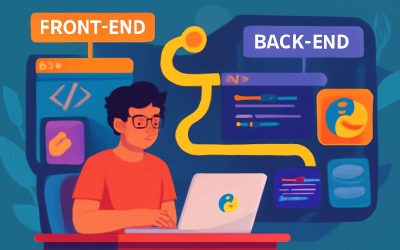Understanding the Role of a Full Stack Developer
What is a Full Stack Developer?
A full stack developer in 30 days might sound ambitious, but understanding the essence of this role is the first step towards that goal. At its core, a full stack developer is a digital artisan—someone who crafts both the visible surface and the underlying architecture of web applications. They seamlessly navigate between front-end and back-end development, creating a harmonious balance that results in user experiences that feel intuitive and robust.
What sets a full stack developer apart is their versatility. They possess the ability to work with multiple programming languages, frameworks, and tools, transforming complex ideas into tangible digital realities. This role demands a deep understanding of both design principles and server-side logic, making them invaluable in fast-paced, innovative environments. If you’re aiming to become a full stack developer in 30 days, grasping this multifaceted nature is crucial, as it underscores the interconnectedness of all elements involved in web development.
Key Skills and Responsibilities
The role of a full stack developer is a tapestry woven from diverse skills and responsibilities, each thread vital to the creation of seamless digital experiences. At its core, this professional must possess a keen eye for both aesthetics and architecture, balancing design finesse with robust server-side logic. In pursuit of becoming a full stack developer in 30 days, understanding the core responsibilities is essential—this journey is as much about mastery as it is about adaptability.
Key skills for a full stack developer include proficiency in multiple programming languages such as JavaScript, Python, or Ruby, alongside familiarity with front-end frameworks like React or Angular. Equally important are back-end technologies such as Node.js or Django, which enable the developer to build scalable and efficient server environments. Their responsibilities often encompass designing intuitive user interfaces while ensuring the underlying database and server infrastructure function flawlessly.
- Developing responsive, user-centric front-end applications.
- Building and maintaining secure, efficient back-end systems.
- Implementing APIs to connect various software components seamlessly.
Ultimately, a full stack developer in 30 days must embody versatility and a relentless curiosity to bridge the gap between design and deployment—an alchemist of the digital realm whose responsibilities extend beyond mere coding to crafting holistic, innovative solutions that resonate with users and stakeholders alike. The journey is demanding, yet the reward lies in mastering the art of creating cohesive, transformative web applications.
Advantages of Becoming a Full Stack Developer
Stepping into the shoes of a full stack developer in just 30 days is akin to unlocking a secret garden of possibilities. This role is a symphony where creativity harmonizes with technical prowess, offering a vantage point from which to orchestrate entire digital landscapes. The advantage? Versatility becomes your hallmark, enabling you to navigate both the front end and back end with equal finesse, a skill highly sought after in South Africa’s dynamic tech scene.
Being a full stack developer in 30 days opens doors to a realm of opportunities. It positions you as a digital artisan capable of transforming abstract ideas into tangible realities. You’ll find yourself crafting user-centric interfaces that captivate, while simultaneously engineering resilient back-end systems that underpin seamless experiences.
- Enhanced employability in a competitive market
- Greater control over project lifecycle from conception to deployment
- Increased earning potential as a versatile developer
In essence, mastering the craft of full stack development within a month offers not just technical mastery but an empowering perspective—one that bridges the realms of design and deployment, turning visions into vibrant, functioning web applications that resonate deeply with users and stakeholders alike.
Preparing for Your 30-Day Full Stack Developer Journey
Assessing Your Current Skill Level
Embarking on a journey to become a full stack developer in 30 days requires more than just enthusiasm; it demands a clear understanding of where you stand. Before diving into intensive learning, it’s essential to assess your current skill level. This honest evaluation acts as your compass, guiding your focus and helping you set realistic milestones along your 30-day path. Recognizing your strengths and identifying gaps can prevent frustration and keep motivation high.
Take stock of your familiarity with basic programming concepts, existing knowledge of front-end and back-end technologies, and your comfort with tools like version control. To streamline your preparation, consider creating a simple self-assessment checklist or engaging in online quizzes. If you find areas that need improvement, allocate time wisely, ensuring your rapid progress toward becoming a full stack developer in 30 days is both feasible and fulfilling.
Setting Realistic Goals
Embarking on the odyssey to become a full stack developer in 30 days is akin to charting a course through uncharted waters—both exhilarating and daunting. Before setting sail, it’s vital to map out your starting point with clarity and intent. Your current skill level is the compass that will steer your journey, revealing hidden depths and guiding your focus toward achievable milestones. This honest assessment fuels your confidence and ensures every step taken is purposeful.
To prepare for this intense voyage, establish a set of realistic goals that resonate with your aspirations and current expertise. Think of these goals as stars in the night sky—each one marking a milestone on your path. Whether it’s mastering a new programming language or understanding the intricacies of databases, delineate what success looks like each week. Remember, the pursuit of becoming a full stack developer in 30 days is a marathon, not a sprint.
- Identify your core strengths and areas for growth.
- Set specific, measurable objectives that challenge yet are attainable within your timeframe.
- Break down your learning journey into manageable modules, focusing on front-end and back-end development in tandem.
In this way, your adventure transforms from a daunting quest into a series of achievable victories, each bringing you closer to the coveted title of a full stack developer in 30 days!
Required Resources and Learning Tools
Embarking on the odyssey to become a full stack developer in 30 days demands more than mere ambition; it calls for the right arsenal of resources and learning tools to illuminate your path. As the digital landscape evolves at a relentless pace, equipping yourself with the essentials is paramount. Imagine your toolkit as a lantern, casting light on the shadowy corners of coding complexities, transforming confusion into clarity.
Essential resources include a robust code editor like Visual Studio Code, comprehensive online courses, and an active community of developers willing to share wisdom. To ensure steady progress, consider utilizing platforms such as GitHub for version control, Stack Overflow for troubleshooting, and freeCodeCamp for hands-on projects. The right combination of these learning tools accelerates your journey and empowers your growth as a full stack developer in 30 days.
Remember, mastery is built on a foundation of consistent practice and access to quality materials. Whether it’s tutorials, coding exercises, or interactive challenges, each resource acts as a stepping stone across the turbulent waters of rapid learning. Prepare your library well, and you’ll find yourself navigating the complex seas of full stack development with confidence and purpose.
Learning Path and Curriculum Breakdown
Week 1: Front-End Development Fundamentals
In the shadowed corridors of digital mastery, embarking on the journey to become a full stack developer in 30 days demands more than mere ambition — it calls for a meticulous apprenticeship. Week one unfolds as a labyrinth of front-end development fundamentals, where the aspiring coder begins to decode the language of pixels and user interaction. Here, the focus is on forging a solid foundation in HTML, CSS, and JavaScript, the very bones of visual storytelling in the digital realm. It’s akin to understanding the whispering secrets of a Gothic cathedral before breathing life into its stained glass windows.
During this initial week, the curriculum is carefully structured to ensure clarity amidst complexity. You will explore:
- HTML structure and semantic elements
- CSS styling and layout techniques
- JavaScript basics and DOM manipulation
These core skills act as the gateway to broader mastery, setting the stage for more advanced pursuits in the subsequent weeks. The goal? To cultivate a keen understanding of how users experience the web, laying the groundwork for a seamless transition into back-end realms and full-fledged development in the days to come.
Week 2: Mastering Front-End Frameworks
Week 2 of the journey to becoming a full stack developer in 30 days takes you deeper into the world of front-end frameworks, where the magic of interactive and dynamic web applications truly begins to unfold. This phase is about refining your skills with popular tools like React, Angular, or Vue.js, which serve as the backbone for modern front-end development. These frameworks transform static pages into engaging experiences that captivate users and keep them coming back.
Understanding these frameworks involves more than just syntax; it’s about grasping their core principles and how they streamline the development process. The curriculum offers a balanced mix of theory and hands-on practice, guiding you through components, state management, and rendering techniques. This immersive learning path ensures you not only learn but also feel confident to craft responsive, user-friendly interfaces—crucial steps on the road to becoming a full stack developer in 30 days.
As you progress, you’ll explore how these frameworks interact with back-end services, setting the stage for seamless integration. The goal? To equip you with the practical knowledge needed to build sophisticated web applications that meet real-world needs, all while nurturing the passion that drives every aspiring full stack developer.
Week 3: Back-End Development Foundations
Week 3 of the journey to becoming a full stack developer in 30 days shifts focus toward foundational back-end development. This phase is critical because it bridges the gap between user-facing interfaces and the server-side logic that powers web applications. The learning path is designed to build a solid understanding of server management, databases, and APIs, which are essential for any aspiring full stack developer aiming to deliver complete solutions.
The curriculum offers a comprehensive breakdown, covering key concepts such as server-side scripting, database integration, and security best practices. You’ll explore popular back-end technologies like Node.js, Express, and SQL databases, gaining hands-on experience in building RESTful APIs and managing data effectively. This balanced approach ensures that learners can see how front-end and back-end components work together seamlessly, paving the way for more sophisticated web applications.
By the end of this week, you’ll have a clearer understanding of how to structure server logic and manage data flow—crucial skills for a full stack developer in 30 days. The journey continues to deepen your technical proficiency while nurturing the problem-solving mindset necessary for real-world application development.
Week 4: Integrating Full Stack Skills & Deployment
As we approach the final phase of the journey to becoming a full stack developer in 30 days, Week 4 offers a transformative focus: integrating skills and mastering deployment. This stage isn’t just about writing code; it’s about understanding the lifecycle of a web application from development to delivery. It’s where technical mastery meets strategic thinking—an essential for anyone aspiring to thrive in today’s digital landscape.
The learning path for this week is designed to deepen your understanding of deploying full stack applications—ensuring they are scalable, secure, and maintainable. The curriculum dissects the nuances of cloud services, version control, and continuous integration, which are pivotal for modern development practices. You’ll explore how to deploy applications effectively, whether through traditional servers or cloud platforms like AWS or Heroku, transforming your static projects into live, accessible solutions.
Key components include understanding deployment pipelines, configuring environments, and orchestrating updates seamlessly. For example, you’ll work through a step-by-step process to:
- Set up staging and production environments
- Utilize Docker containers for consistency
- Implement automated testing and deployment workflows
This comprehensive approach ensures that as a full stack developer in 30 days, you’re not just coding—you’re delivering real-world solutions that can be accessed, scaled, and maintained with confidence. The focus on integration and deployment cements the bridge between development and operational excellence, a vital skill in today’s competitive tech landscape.
Practical Tips for Accelerated Learning
Hands-On Projects and Coding Challenges
Embarking on the journey to become a full stack developer in 30 days is akin to unlocking a secret garden of endless possibilities. To truly accelerate your learning, immerse yourself in hands-on projects that breathe life into theory. Practical application transforms abstract concepts into tangible skills, making your growth both vibrant and sustainable. Engage in coding challenges that push your boundaries—each bug fixed, each feature built, a step closer to mastery.
One way to sharpen your skills swiftly is to set up mini-projects that mirror real-world scenarios. For example, build a simple e-commerce site or a blog platform, integrating both front-end and back-end elements. This approach not only cements your understanding but also creates a compelling portfolio that speaks to your newfound expertise. Remember, consistency in practice is key—dedicate time daily to coding, and watch how your confidence blossoms.
To keep momentum high, consider joining online coding communities or hackathons—these are fertile grounds for feedback and inspiration. With each challenge, you’re weaving the tapestry of your full stack developer in 30 days, transforming ambition into tangible achievement. The magic lies in sustained effort and the thrill of turning ideas into digital reality.
Utilizing Online Resources and Tutorials
Harnessing online resources and tutorials is the secret weapon for fast-tracking your journey to becoming a full stack developer in 30 days. The digital landscape offers a treasure trove of structured courses, interactive platforms, and comprehensive tutorials that can transform your learning curve from steep to smooth. Platforms like Udemy, Coursera, and freeCodeCamp provide meticulously curated content, guiding you step-by-step through both front-end and back-end development essentials.
To maximize efficiency, focus on creating a disciplined routine that blends watching tutorials with immediate application. Engaging with community forums such as Stack Overflow or Reddit’s programming threads allows you to troubleshoot real-time issues, deepening your understanding. Remember, the key to mastering all facets of full stack development in 30 days is consistent, deliberate practice.
- Identify a clear learning path aligned with your goals.
- Utilize practical tutorials that include hands-on exercises.
- Participate actively in online coding communities for feedback and motivation.
By leveraging these online resources, you not only accelerate your skill acquisition but also gain insights into industry best practices. This dynamic approach ensures your journey to becoming a full stack developer in 30 days is both immersive and impactful—fueling your confidence as you transform theory into tangible digital solutions.
Joining Developer Communities
Joining developer communities is the secret sauce to turbocharge your journey to becoming a full stack developer in 30 days. These vibrant hubs of coding camaraderie offer not only moral support but also real-world insights that no YouTube tutorial can match. Whether it’s Reddit’s programming threads or Stack Overflow, engaging actively helps you troubleshoot bugs faster and learn industry best practices firsthand.
To truly accelerate your learning curve, consider participating in online code sprints and hackathons—these are perfect for pushing your boundaries and testing your skills under pressure. Here’s a quick tip: make a habit of asking questions, no matter how trivial they seem. The more you interact, the more you internalize complex concepts, transforming theory into tangible skills.
Remember, building a network of fellow aspiring full stack developers in 30 days not only boosts your confidence but also keeps you motivated through shared struggles and victories. The community’s collective wisdom is invaluable—think of it as having a team of mentors cheering you on from afar. Dive in, stay curious, and watch your full stack developer in 30 days transformation unfold with a bit of digital camaraderie and a lot of coffee.
Time Management Strategies
Time is of the essence when aiming to become a full stack developer in 30 days. With the clock ticking, mastering practical time management strategies becomes your best weapon against procrastination and burnout. The trick isn’t just about working harder — it’s about working smarter. Setting specific, achievable milestones keeps momentum high and prevents the dreaded overwhelm from creeping in. Remember, consistency beats intensity; even 2-3 focused hours daily can lead to monumental progress.
Another golden rule is batching your learning sessions. By dedicating blocks of uninterrupted time—say, a solid morning session—you can dive deep without distractions. Incorporate techniques like the Pomodoro Method to stay sharp and avoid mental fatigue. Keep a visual progress tracker; every completed challenge or quiz is a mini-victory that fuels your motivation for the next day.
To supplement your journey to becoming a full stack developer in 30 days, consider leveraging digital tools for time management. Apps like Trello or Notion can help you organize your syllabus and track your goals. Remember, in this high-stakes race, every moment counts—so carve out your dedicated learning hours and stick to them like glue. After all, in the quest to be a full stack developer in 30 days, strategic time management isn’t just a tip; it’s your secret weapon.
Building Your Portfolio as a Full Stack Developer
Showcasing Your Projects
Building your portfolio as a full stack developer in 30 days is akin to crafting a mosaic from shards of raw potential into a masterpiece of ingenuity. This collection of your projects becomes the mirror reflecting your evolving skills, a testament to your dedication and mastery. Showcasing your projects with clarity and polish not only demonstrates your technical prowess but also narrates your journey from novice to artisan.
Consider creating a dedicated website where each project tells its own story, highlighting the problem solved and the technologies employed. Incorporate live demos, code snippets, and detailed descriptions to captivate potential employers or clients. Remember, an impressive portfolio is more than a showcase; it’s a living testament to your progress and passion in becoming a full stack developer in 30 days!
Creating a Professional GitHub Profile
In the bustling realm of tech talent, a compelling GitHub profile serves as your digital handshake—polished, professional, and unmistakably authentic. For aspiring full stack developers in 30 days, creating a standout GitHub profile isn’t just a formality; it’s the cornerstone of your burgeoning reputation. Think of it as your personal gallery, where each commit whispers tales of problem-solving prowess and coding finesse.
To craft an impressive profile, ensure your repositories are meticulously organized, with clear documentation and engaging README files. Highlight your most ambitious projects—perhaps a dynamic web app or a RESTful API—and include live demos whenever possible. A strategic use of tags and keywords enhances discoverability, making your profile more appealing to potential employers or clients seeking a full stack developer in 30 days. Remember, your GitHub profile is not merely a showcase but a narrative of your journey from novice to artisan in the world of full stack development.
Networking and Job Search Tips
Building your portfolio as a full stack developer in 30 days is a vital step towards standing out in a competitive tech landscape. Your portfolio isn’t just a collection of projects; it’s a living testament to your growth, resilience, and dedication. In a world where opportunities are increasingly digital, showcasing your work with clarity and passion can open doors you never imagined.
Focus on curating projects that demonstrate both your front-end finesse and back-end expertise. Think of your portfolio as a storybook—each project should highlight a different chapter of your journey. Incorporate real-world challenges, like a dynamic web app or a RESTful API, that showcase your problem-solving prowess. Remember, potential employers or clients want to see tangible evidence of your skills, so including live demos and detailed documentation can make all the difference.
Networking plays a crucial role in your journey to become a full stack developer in 30 days. Engaging with developer communities, both online and locally, can provide invaluable insights and support. Attend meetups, participate in forums, and share your projects—these interactions not only expand your knowledge but also increase your visibility in the industry. Sometimes, a simple conversation or feedback from a seasoned developer can accelerate your growth exponentially.
To maximize your reach, consider leveraging social platforms like LinkedIn and Twitter, where thoughtful posts about your progress or challenges can attract recruiters and industry peers. Building meaningful relationships—rather than just collecting followers—can lead to mentorships and job opportunities. Remember, the journey to mastering full stack development in 30 days isn’t solely about coding; it’s about weaving yourself into a community that values continuous learning and shared success.
Common Pitfalls and How to Overcome Them
Avoiding Burnout
Embarking on the journey to become a full stack developer in 30 days is exhilarating, but it’s also fraught with unseen pitfalls. The relentless pursuit of mastery often leads to burnout—an insidious enemy that saps your enthusiasm and diminishes your progress. Recognizing these emotional and mental snares early can mean the difference between sustainable growth and frustration. The key lies in understanding that growth isn’t linear; it’s a complex dance between effort and exhaustion.
Common pitfalls include neglecting self-care, overloading on learning material, and underestimating the importance of rest. These missteps can be avoided by cultivating a disciplined approach that emphasizes balance. A helpful strategy is to schedule regular breaks and set boundaries—remember, even the most ambitious full stack developer in 30 days needs time to process and assimilate new skills. Incorporating mindful practices and realistic expectations ensures you maintain the stamina needed to sustain your quest without sacrificing your well-being.
Maintaining Consistency
Embarking on the journey to become a full stack developer in 30 days is a thrilling adventure, but one fraught with potential pitfalls. Many aspiring developers fall into the trap of neglecting essential self-care or overloading themselves with an avalanche of new information. This relentless pace can quickly lead to burnout, a silent enemy that diminishes enthusiasm and hampers progress. Recognizing these dangers early is crucial to maintaining momentum and ensuring steady growth.
To stay on course, it’s vital to maintain consistency by setting clear boundaries and incorporating regular breaks into your daily routine. A disciplined approach that emphasizes balance helps prevent exhaustion and keeps motivation high. For instance, scheduling short, mindful pauses between study sessions allows your brain to process and retain complex concepts more effectively. Remember, even the most dedicated full stack developer in 30 days needs time to assimilate new skills and avoid burnout.
- Prioritize self-care and mental well-being
- Set achievable daily goals to avoid overwhelm
- Incorporate mindfulness and relaxation practices
By weaving these strategies into your learning journey, you’ll forge a resilient path that blends intense study with essential rest—transforming the challenge of becoming a full stack developer in 30 days into an enriching adventure rather than a frantic race against time.
Seeking Feedback and Mentorship
In the pursuit of becoming a full stack developer in 30 days, many stumble over the twin pitfalls of seeking instant mastery and neglecting the profound importance of mentorship. Without guidance, the journey can become a maze of confusion, leading to frustration rather than progress. Seeking feedback from experienced developers not only illuminates blind spots but also accelerates growth, transforming raw effort into strategic learning.
However, finding the right mentorship can be elusive. It requires patience and discernment—identifying those who can challenge you without overwhelming you. An effective way to overcome this is to actively participate in developer communities, where peer reviews and constructive criticism foster resilience and deepen understanding. Remember, no full stack developer in 30 days can afford to work in isolation; connection fuels mastery.
To truly thrive, embrace an openness to critique and cultivate relationships that inspire continuous learning. By doing so, the arduous process of rapid skill acquisition becomes a shared voyage—one where collective wisdom and honest feedback propel you toward your goal.




0 Comments